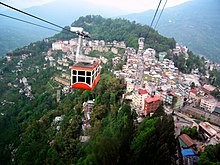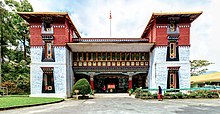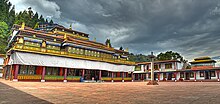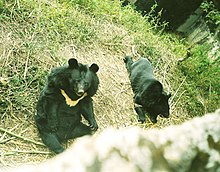Gangtok is the capital of the mountainous northern Indian state of Sikkim. Established as a Buddhist pilgrimage site in the 1840s, the city became capital of an independent monarchy after British rule ended, but joined India in 1975. Today, it remains a Tibetan Buddhist center and a base for hikers organizing permits and transport for treks through Sikkim’s Himalayan mountain ranges.
Things To Do In Gangtok


















































Things To Do In Gangtok
Namgyal Institute of Tibetology
Museum & library of Tibetan culture

Tashi View Point
Platform for taking in mountain views

Hanuman Tok
Hindu temple with scenic mountain views

Enchey Monastery
Tranquil hilltop Buddhist monastery
Ganesh Tok
Hilltop temple with an observation deck
Mahatma Gandhi Marg
Shopping

Ropeway
Banjhakri Falls and Energy Park
Waterfall and monastery
Sikkim Himalayan Zoological Park
Vast wildlife park with mountain views
Bakthang Waterfall
Scenic waterfall cascading into a pool
RANKA MONASTERY
Monastery and architecture
Rumtek Monastery
Buddhist monastery in a serene setting

Lal Bazar Road
Shopping
Lingdum Monastery
Colorful monastery in lush surrounds
Deorali Road
Monastery and shopping
Do Drul Chorten Monastery
Monastery
Gonjang Monastery
Monastery
M.G MARKET
Gangtok Ropeway
Thakurbari Temple, Gangtok
Temple
Pangthang Football Playground
Ridge Flower Park
Nathu La
Mountain pass off the ancient Silk Road

Pemayangtse Monastery
Historic monastery with Buddhist art

Flower Exhibition Centre - Ridge Park.
Ganeshtok Gangtok
Flower Show Centre
Khecheopalri Lake
Buddhist & Hindu pilgrimage destination

Deorali Butterfly Bridge
Saramsa Garden
Botanical garden with plants & flowers
Casino Deltin Denzong
Casino
Kyongnosla Alpine Sanctuary
Wildlife sanctuary with rare plants
Flower Exhibition Center
Titanic Park
Park
Phodong Monastery
Monastery and buddhism

White Hall
Casino Mahjong
Gambling, entertainment & a buffet
Plant Conservatory
Mahatma Gandhi Statue
View Point
Kanchendzonga national park
Himalayan scenery & wildlife
Jawaharlal Nehru Botanical Garden
Garden with flowers, fountains & more
Phensang Monastery
Monastery and buddhism
Tashi View Point, Bojoghari
Shiv Temple
Kanchendzonga Amusement Park, Ranka, Sikkim
Nam Nam View Point
Elevated lookout point with valley views
Children's Park
Shanti Viewpoint
Karma Shri Nalanda Institute
Monastery
Transport
Road
Taxis are the most widely available public transport within Gangtok. Most of the residents stay within a few kilometres of the town centre and many have their own vehicles such as two-wheelers and cars. The share of personal vehicles and taxis combined is 98% of Gangtok's total vehicles, a high percentage when compared to other Indian cities. City buses comprise less than one percent of vehicles. Those travelling longer distances generally make use of share-jeeps, a kind of public taxis. Four wheel drives are used to easily navigate the steep slopes of the roads. The 1 km (0.6 mi) long cable car with three stops connects lower Gangtok suburbs with Sikkim Legislative assembly in central Gangtok and the upper suburbs.
Gangtok is connected to the rest of India by an all-weather metalled highway, National Highway 10, earlier known as National Highway 31A, which links Gangtok to Siliguri, located 114 km (71 mi) away in the neighbouring state of West Bengal. The highway also provides a link to the neighbouring hill station towns of Darjeeling and Kalimpong, which are the nearest urban areas. Regular jeep, van, and bus services link these towns to Gangtok. Gangtok is a linear city that has developed along the arterial roads, especially National Highway 31A.[11] Most of the road length in Gangtok is of two lane undivided carriageway with footpath on one side of the road and drain on the other. The steep gradient of the different road stretches coupled with a spiral road configuration constrain the smooth flow of vehicular as well as pedestrian traffic.
Rail
The nearest railhead connected to the rest of India is the station of New Jalpaiguri in Siliguri, situated 124 km (77 mi) away from Gangtok. Work has commenced for a broad gauge railway link from Sevoke in West Bengal to Rangpo in Sikkim that is planned for extension to Gangtok.[38]
Air
Pakyong Airport, a Greenfield project near Gangtok, was commissioned in 2018. It is the first and only airport in Sikkim.
Culture
Apart from the major religious festivals of Dashain, Tihar, Christmas, Holi etc., the diverse ethnic populace of the town celebrates several local festivals. The Lepchas and Bhutias celebrate new year in January, while Tibetans celebrate the new year (Losar) with "Devil Dance" in January–February. The Maghe sankranti, Ram Navami are some of the important Nepalese festivals. Chotrul Duchen, Buddha Jayanti, the birthday of the Dalai Lama, Loosong, Bhumchu, Saga Dawa, Lhabab Duechen and Drupka Teshi are some other festivals, some distinct to local culture and others shared with the rest of India, Nepal, Bhutan and Tibet.
A popular food in Gangtok is the momo, a steamed dumpling containing pork, beef and vegetables cooked in a doughy wrapping and served with watery soup. Wai-Wai is a packaged snack consisting of noodles which are eaten either dry or in soup form. A form of noodle called thukpa, served in soup form is also popular in Gangtok. Other noodle-based foods such as the chowmein, thenthuk, fakthu, gyathukand wonton are available. Other traditional Sikkimese cuisine include shah-phaley (Sikkimese patties with spiced minced meat in a crisp samosa-like case) and Gack-ko soup. Restaurants offer a wide variety of traditional Indian, continental and Chinese cuisines to cater to the tourists. Churpee, a kind of hard cheese made from cow's or yak's milk is sometimes chewed. Chhang is a local frothy millet beer traditionally served in bamboo tankards and drunk through bamboo or cane straws.
Football (soccer), cricket and archery are the most popular sports in Gangtok. The Paljor Stadium, which hosts football matches, is the sole sporting ground in the city. Thangka—a notable handicraft—is an elaborately hand painted religious scroll in brilliant colours drawn on fabric hung in a monastery or a family altar and occasionally carried by monks in ceremonial processions. Chhaams are vividly costumed monastic dances performed on ceremonial and festive occasions, especially in the monasteries during the Tibetan new year.
City institutions
A centre of Buddhist learning and culture, Gangtok's most notable Buddhist institutions are the Enchey monastery, the Do-drul Chorten stupa complex and the Rumtek Monastery. The Enchey monastery is the city's oldest monastery and is the seat of the Nyingma order.The two-hundred-year-old baroque monastery houses images of gods, goddesses, and other religious artifacts.
In the month of January, the Chaam, or masked dance, is performed with great fanfare. The Dro-dul Chorten is a stupa which was constructed in 1945 by Trulshik Rimpoché, head of the Nyingma order of Tibetan Buddhism.[43] Inside this stupa are complete set of relics, holy books, and mantras. Surrounding the edifice are 108 Mani Lhakor, or prayer wheels. The complex also houses a religious school.
The Rumtek Monastery on the outskirts of the town is one of Buddhism's most sacred monasteries. The monastery is the seat of the Kagyu order, one of the major Tibetan sects, and houses some of the world's most sacred and rare Tibetan Buddhist scriptures and religious objects in its reliquary. Constructed in the 1960s, the building is modeled after a similar monastery in Lhasa, Tibet. Rumtek was the focus of international media attention in 2000 after the seventeenth Karmapa, one of the four holiest lamas, fled Lhasa and sought refuge in the monastery.
The Namgyal Institute of Tibetology, better known as the Tibetology Museum, houses a huge collection of masks, Buddhist scriptures, statues, and tapestries. It has over two hundred Buddhist icons, and is a centre of study of Buddhist philosophy. The Thakurbari Temple, located in the heart of the city, established in 1935 on a prime piece of land donated by the then Maharaja of Sikkim, is one of the oldest and best-known Hindu temples in the city. The Ganesh Tok and the Hanuman Tok, dedicated to the Hindu gods Ganpati and Hanuman and housing important Hindu deities, are located in the upper reaches of the city. The Himalayan Zoological Park exhibits the fauna of the Himalayas in their natural habitats. The zoo features the Himalayan black bear, red pandas, the barking deer, the snow leopard, the leopard cat, Tibetan wolf, masked palm civet and the spotted deer, amongst the others. Jawaharlal Nehru Botanical Gardens, near Rumtek, houses many species of orchid and as many as fifty different species of tree, including many oaks.
History
Like the rest of Sikkim, not much is known about the early history of Gangtok. The earliest records date from the construction of the hermitic Gangtok monastery in 1716. Gangtok remained a small hamlet until the construction of the Enchey Monastery in 1840 made it a pilgrimage center. It became the capital of what was left of Sikkim after an English conquest in the mid-19th century in response to a hostage crisis. After the defeat of the Tibetans by the British, Gangtok became a major stopover in the trade between Tibet and British India at the end of the 19th century. Most of the roads and the telegraph in the area were built during this time.
In 1894, Thutob Namgyal, the Sikkimese monarch under British rule, shifted the capital from Tumlong to Gangtok, increasing the city's importance. A new grand palace along with other state buildings was built in the new capital. Following India's independence in 1947, Sikkim became a nation-state with Gangtok as its capital. Sikkim came under the suzerainty of India, with the condition that it would retain its independence, by the treaty signed between the Chogyal and the then Indian Prime Minister Jawaharlal Nehru.This pact gave the Indians control of external affairs on behalf of Sikkimese. Trade between India and Tibet continued to flourish through the Nathula and Jelepla passes, offshoots of the ancient Silk Road near Gangtok. These border passes were sealed after the Sino-Indian War in 1962, which deprived Gangtok of its trading business. The Nathula pass was finally opened for limited trade in 2006, fuelling hopes of economic boom.
In 1975, after years of political uncertainty and struggle, including riots, the monarchy was abrogated and Sikkim became India's twenty-second state, with Gangtok as its capital after a referendum. Gangtok has witnessed annual landslides, resulting in loss of life and damage to property. The largest disaster occurred in June 1997, when 38 were killed and hundreds of buildings were destroyed.[11]
Geography
Gangtok is located at 27.3325°N 88.6140°E (coordinates of Gangtok head post office). It is situated in the lower Himalayas at an elevation of 1,650 m (5,410 ft). The town lies on one side of a hill, with "The Ridge", a promenade housing the Raj Bhawan, the governor's residence, at one end and the palace, situated at an altitude of about 1,800 m (5,900 ft), at the other. The city is flanked on east and west by two streams, namely Roro Chu and Ranikhola, respectively. These two rivers divide the natural drainage into two parts, the eastern and western parts. Both the streams meet the Ranipul and flow south as the main Ranikhola before it joins the Teesta at Singtam. Most of the roads are steep, with the buildings built on compacted ground alongside them.
Most of Sikkim, including Gangtok, is underlain by Precambrian rocks which contains foliated phyllites and schists; slopes are therefore prone to frequent landslides. Surface runoff of water by natural streams (jhora) and man-made drains has contributed to the risk of landslides. According to the Bureau of Indian Standards, the town falls under seismic zone-IV (on a scale of I to V, in order of increasing seismic activity), near the convergent boundary of the Indian and the Eurasian tectonic plates and is subject to frequent earthquakes. The hills are nestled within higher peaks and the snow-clad Himalayan ranges tower over the town from the distance. Mount Kanchenjunga (8,598 m or 28,208 ft)—the world's third-highest peak—is visible to the west of the city. The existence of steep slopes, vulnerability to landslides, large forest cover and inadequate access to most areas have been a major impediment to the natural and balanced growth of the city.
There are densely forested regions around Gangtok, consisting of temperate, deciduous forests of poplar, birch, oak, and elm, as well as evergreen, coniferous trees of the wet alpine zone.[ Orchids are common, and rare varieties of orchids are featured in flower shows in the city. Bamboos are also abundant. In the lower reaches of the town, the vegetation gradually changes from alpine to temperate deciduous and subtropical. Flowers such as sunflower, marigold, poinsettia, and others bloom, especially in November and December.













No comments:
Post a Comment